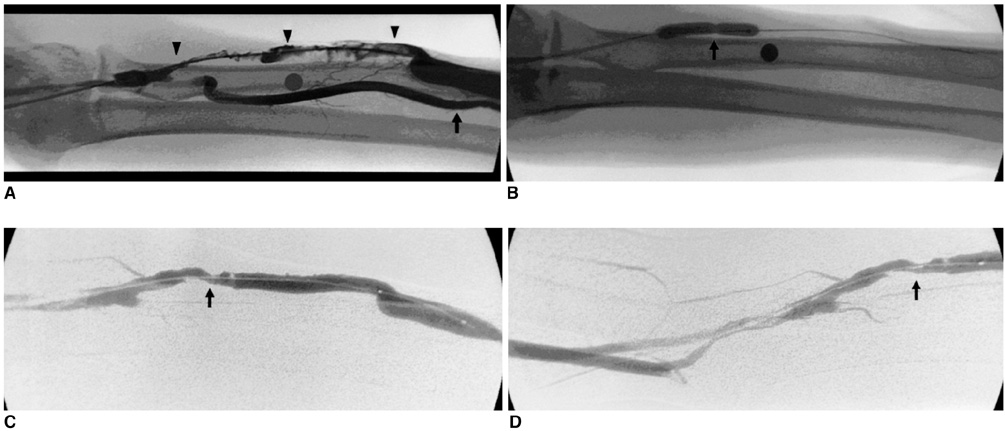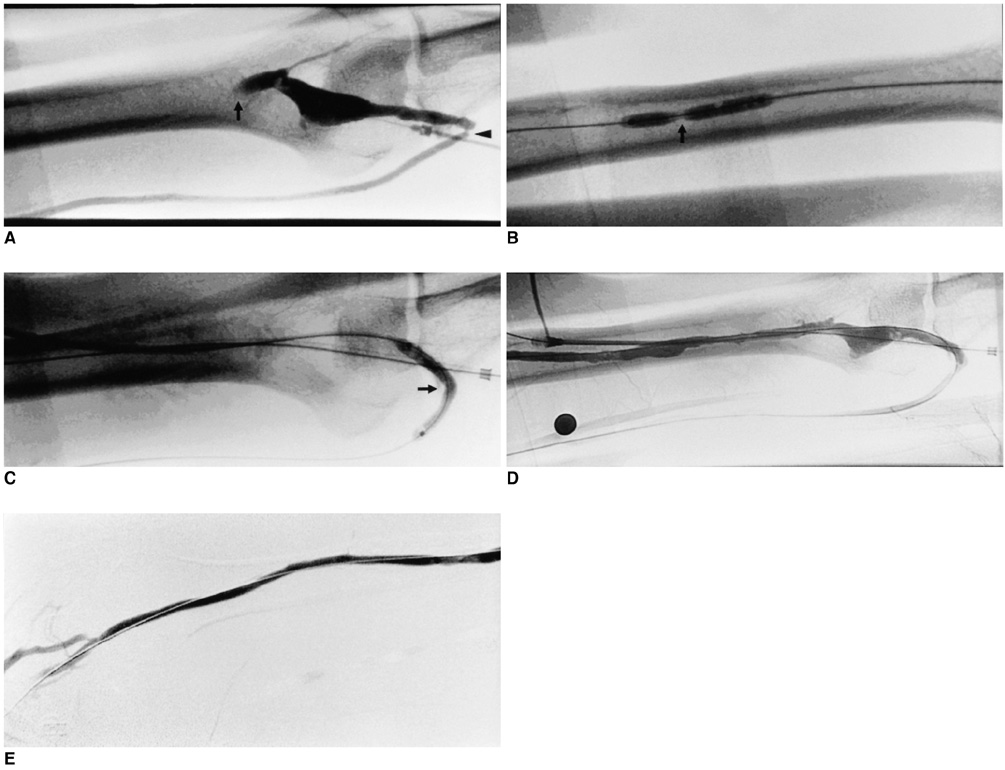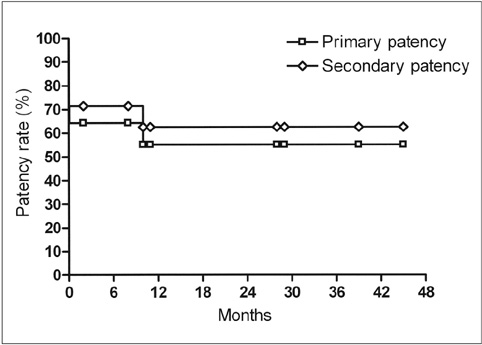Korean J Radiol.
2006 Sep;7(3):180-186. 10.3348/kjr.2006.7.3.180.
Percutaneous Treatment of Failed Native Dialysis Fistulas: Use of Pulse-Spray Pharmacomechanical Thrombolysis as the Primary Mode of Therapy
- Affiliations
-
- 1Department of Radiology and Center for Imaging Science, Samsung Medical Center, Sungkyunkwan University School of Medicine, Seoul, Korea. swshin@smc.samsung.co.kr
- 2Department of Radiology, Kangwon National University College of Medicine, Gangwon-do, Korea.
- KMID: 1114350
- DOI: http://doi.org/10.3348/kjr.2006.7.3.180
Abstract
OBJECTIVE
To determine the efficacy and outcome of percutaneous treatment in restoring the function of failed native arteriovenous fistulas (AVFs) where pulse-spray pharmacomechanical thrombolysis was used as the primary mode of therapy. MATERIALS AND METHODS: From June 2001 to July 2005, 14 patients who had thrombosis of native AVFs underwent percutaneous restoration following 20 episodes of thrombosis. These included 6 repeated episodes in one forearm AVF and two episodes in another forearm AVF. All patients except one were treated with urokinase injection utilizing the pulse-spray technique and had subsequent balloon angioplasty. One patient was treated by percutaneous angioplasty alone. We retrospectively evaluated the feasibility of percutaneous treatment in restoring the function of the failed AVFs. The primary and secondary patencies were calculated by using a Kaplan-Meier analysis. RESULTS: Both technical and clinical success were achieved in 15 (75%) of 20 AVFs. Four of the five technical failures resulted from a failure to cross the occluded segment. One patient refused further participation in the trial through a brachial artery access following failure to cross the occluded segment via an initial retrograde venous puncture. There were no major precedure related complications observed. Including the initial technical failures, primary patency rates at six and 12 months were 64% and 55%, respectively. Secondary patency rates at six and 12 months were 71% and 63%, respectively. CONCLUSION: Pulse-spray pharmacomechanical thrombolysis for treatment of the thrombosed AVFs is safe, effective and durable. This procedure should be considered as an option for the management of failed AVFs prior to surgical intervention.
MeSH Terms
Figure
Reference
-
1. Mailloux LU, Bellucci AG, Napolitano B, Mossey T, Wilkes BM, Bluestone PA. Survival estimates for 683 patients starting dialysis from 1970 through 1989: identification of risk factors for survival. Clin Nephrol. 1994. 42:127–135.2. Chazan JA, London MR, Pono LM. Long-term survival of vascular accesses in a large chronic hemodialysis population. Nephron. 1995. 69:228–233.3. I. NKF-K/DOQI Clinical Practice Guidelines for Hemodialysis Adequacy: update 2000. Am J Kidney Dis. 2001. 37:S7–S64.4. Beathard GA. Lameire N, Mehta R, editors. Complications of vascular access. Complications of dialysis-recognition and management. 2000. New York: Marcel Dekker;1–27.5. Palder SB, Kirkman RL, Whittemore AD, Hakim RM, Lazarus JM, Tilney NL. Vascular access for hemodialysis. Patency rates and results of revision. Ann Surg. 1985. 202:235–239.6. Burger H, Kluchert BA, Kootstra G, Kitslaar PJ, Ubbink DT. Survival of arteriovenous fistulas and shunts for haemodialysis. Eur J Surg. 1995. 161:327–334.7. Schwab SJ, Raymond JR, Saeed M, Newman GE, Dennis PA, Bollinger RR. Prevention of hemodialysis fistula thrombosis. Early detection of venous stenoses. Kidney Int. 1989. 36:707–711.8. Riordan S, Frawley J, Gray L, Niesche J. Primary access surgery for long-term haemodialysis. Aust N Z J Surg. 1994. 64:763–767.9. Kumpe DA, Cohen MA. Angioplasty/thrombolytic treatment of failing and failed hemodialysis access sites: comparison with surgical treatment. Prog Cardiovasc Dis. 1992. 34:263–278.10. Zaleski GX, Funaki B, Kenney S, Lorenz JM, Garofalo R. Angioplasty and bolus urokinase infusion for the restoration of function in thrombosed Brescia-Cimino dialysis fistulas. J Vasc Interv Radiol. 1999. 10:129–136.11. Turmel-Rodrigues L, Sapoval M, Pengloan J, Billaux L, Testou D, Hauss S, et al. Manual thromboaspiration and dilation of thrombosed dialysis access: mid-term results of a simple concept. J Vasc Interv Radiol. 1997. 8:813–824.12. Turmel-Rodrigues L, Pengloan J, Rodrigue H, Brillet G, Lataste A, Pierre D, et al. Treatment of failed native arteriovenous fistulae for hemodialysis by interventional radiology. Kidney Int. 2000. 57:1124–1140.13. Rocek M, Peregrin JH, Lasovickova J, Krajickova D, Slaviokova M. Mechanical thrombolysis of thrombosed hemodialysis native fistulas with use of the Arrow-Trerotola percutaneous thrombolytic device: our preliminary experience. J Vasc Interv Radiol. 2000. 11:1153–1158.14. Overbosch EH, Pattynama PM, Aarts HJ, Schultze Kool LJ, Hermans J, Reekers JA. Occluded hemodialysis shunts: dutch multicenter experience with the hydrolyser catheter. Radiology. 1996. 201:485–488.15. Haage P, Vorwerk D, Wildberger JE, Piroth W, Schurmann K, Gunther RW. Percutaneous treatment of thrombosed primary arteriovenous hemodialysis access fistulae. Kidney Int. 2000. 57:1169–1175.16. Schmitz-Rode T, Wildberger JE, Hubner D, Wein B, Schurmann K, Gunther RW. Recanalization of thrombosed dialysis access with use of a rotating mini-pigtail catheter: follow-up study. J Vasc Interv Radiol. 2000. 11:721–727.17. Schon D, Mishler R. Salvage of occluded autologous arteriovenous fistulae. Am J Kidney Dis. 2000. 36:804–810.18. Liang HL, Pan HB, Chung HM, Ger LP, Fang HC, Wu TH, et al. Restoration of thrombosed Brescia-Cimino dialysis fistulas by using percutaneous transluminal angioplasty. Radiology. 2002. 223:339–344.19. Rajan DK, Clark TW, Simons ME, Kachura JR, Sniderman K. Procedural success and patency after percutaneous treatment of thrombosed autogenous arteriovenous dialysis fistulas. J Vasc Interv Radiol. 2002. 13:1211–1218.20. Aruny JE, Lewis CA, Cardella JF, Cole PE, Davis A, Drooz AT, et al. Quality improvement guidelines for percutaneous management of the thrombosed or dysfunctional dialysis access. Standards of Practice Committee of the Society of Cardiovascular & Interventional Radiology. J Vasc Interv Radiol. 1999. 10:491–498.21. Middlebrook MR, Amygdalos MA, Soulen MC, Haskal ZJ, Shlansky-Goldberg RD, Cope C, et al. Thrombosed hemodialysis grafts: percutaneous mechanical balloon declotting versus thrombolysis. Radiology. 1995. 196:73–77.22. Gray RJ. Percutaneous intervention for permanent hemodialysis access: a review. J Vasc Interv Radiol. 1997. 8:313–327.23. Gibbens DT, Triolo J, Yu T, Depalma J, Iglasias J, Castner D. Contemporary treatment of thrombosed hemodialysis grafts. Tech Vasc Interv Radiol. 2001. 4:122–126.24. Sofocleous CT, Cooper SG, Schur I, Patel RI, Iqbal A, Walker S. Retrospective comparison of the Amplatz thrombectomy device with modified pulse-spray pharmacomechanical thrombolysis in the treatment of thrombosed hemodialysis access grafts. Radiology. 1999. 213:561–567.25. Kinney TB, Valji K, Rose SC, Yeung DD, Oglevie SB, Roberts AC, et al. Pulmonary embolism from pulse-spray pharmacomechanical thrombolysis of clotted hemodialysis grafts: urokinase versus heparinized saline. J Vasc Interv Radiol. 2000. 11:1143–1152.26. Kim DH, Goo DE, Yang SB, Moon C, Choi DL. Endovascular management of immediate procedure-related complications of failed hemodialysis access recanalization. Korean J Radiol. 2005. 6:185–195.
- Full Text Links
- Actions
-
Cited
- CITED
-
- Close
- Share
- Similar articles
-
- The Modified Pulse-Spray Method Using Urokinase in Subacute and Chronic Thrombotic Arterial Occlusion
- Efficacy of a Modified Pharmacomechanical Thrombolysis Technique for Endovascular Treatment of Thrombosed Prosthetic Arteriovenous Grafts
- A Case of Mechanical Thrombolysis of Thrombosed Native Hemodialysis Fistula Using Arrow Trerotola Percutaneous Thrombolytic Device
- Percutaneous Treatment of Thrombosed Native Arteriovenous Dialysis Fistula Insufficiency: Efficacy of Mechanical Thrombectomy with Using the Stone Basket
- Clinical outcome of percutaneous thrombectomy of dialysis access thrombosis by an interventional nephrologist




